SS4017 Essay: Benefit System's Role in Work Obligation (1997-Present)
VerifiedAdded on 2023/04/25
|12
|3165
|292
Essay
AI Summary
This essay delves into the UK's benefit system, examining how governments since 1997 have utilized it to enforce work obligations. It explores the various types of benefits, including Jobseeker's Allowance, Support Allowance, Housing Benefit, Disability Living Allowance, and Carer's Allowance, and the departments that administer them. The essay investigates how the government uses the benefit system to encourage work across different demographics, such as the working age, retirees, and families with children, and analyzes the changes to the system, including the Welfare Reform Act of 2012. Furthermore, the essay assesses the impacts of the benefit system, highlighting its influence on employment rates, the income gap between rich and poor, employment opportunities for vulnerable groups, and poverty levels. The essay uses academic sources to support its claims and provides a comprehensive overview of the subject.

BENEFIT SYSTEM 1
Benefit system
Name
Course
Unit
Lecturer
Date
Benefit system
Name
Course
Unit
Lecturer
Date
Paraphrase This Document
Need a fresh take? Get an instant paraphrase of this document with our AI Paraphraser
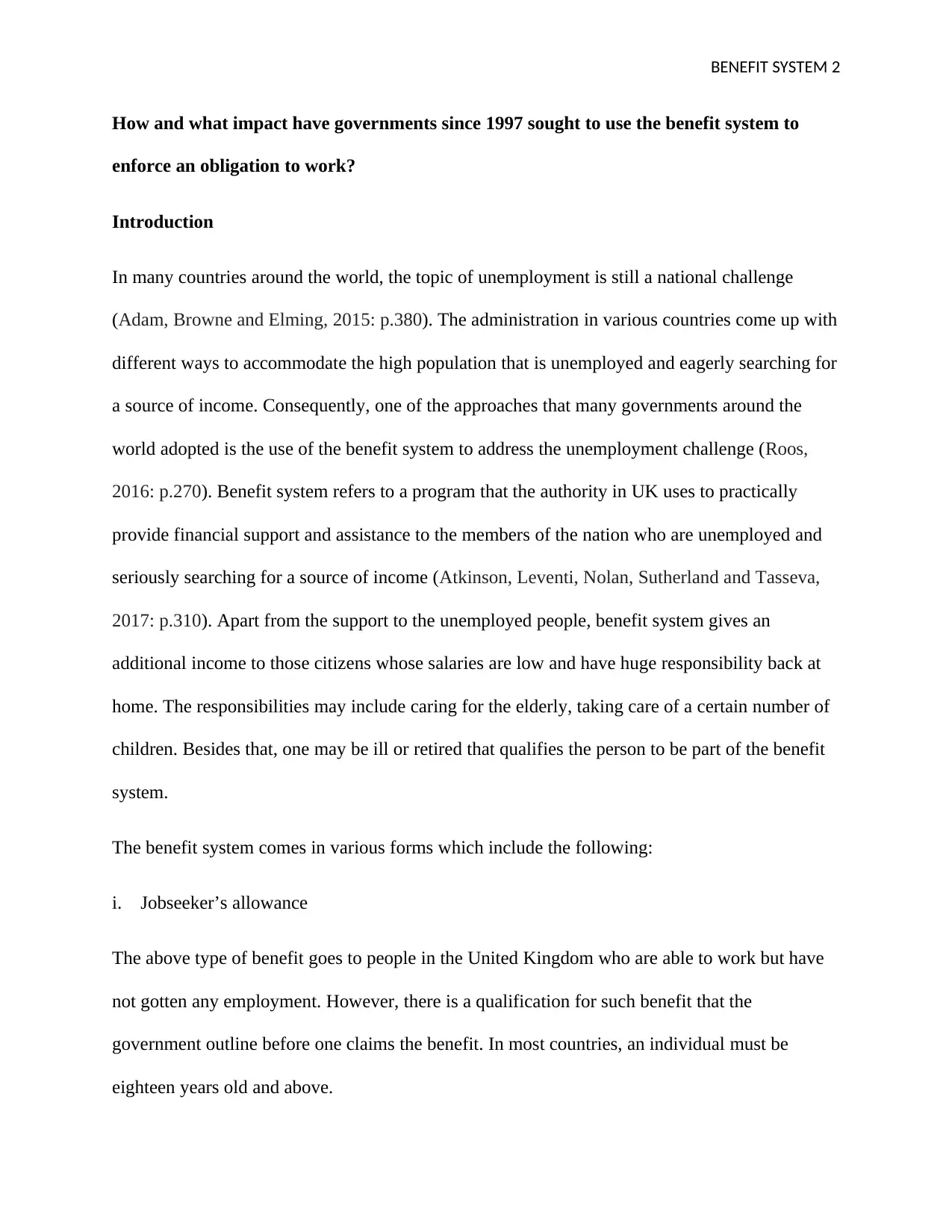
BENEFIT SYSTEM 2
How and what impact have governments since 1997 sought to use the benefit system to
enforce an obligation to work?
Introduction
In many countries around the world, the topic of unemployment is still a national challenge
(Adam, Browne and Elming, 2015: p.380). The administration in various countries come up with
different ways to accommodate the high population that is unemployed and eagerly searching for
a source of income. Consequently, one of the approaches that many governments around the
world adopted is the use of the benefit system to address the unemployment challenge (Roos,
2016: p.270). Benefit system refers to a program that the authority in UK uses to practically
provide financial support and assistance to the members of the nation who are unemployed and
seriously searching for a source of income (Atkinson, Leventi, Nolan, Sutherland and Tasseva,
2017: p.310). Apart from the support to the unemployed people, benefit system gives an
additional income to those citizens whose salaries are low and have huge responsibility back at
home. The responsibilities may include caring for the elderly, taking care of a certain number of
children. Besides that, one may be ill or retired that qualifies the person to be part of the benefit
system.
The benefit system comes in various forms which include the following:
i. Jobseeker’s allowance
The above type of benefit goes to people in the United Kingdom who are able to work but have
not gotten any employment. However, there is a qualification for such benefit that the
government outline before one claims the benefit. In most countries, an individual must be
eighteen years old and above.
How and what impact have governments since 1997 sought to use the benefit system to
enforce an obligation to work?
Introduction
In many countries around the world, the topic of unemployment is still a national challenge
(Adam, Browne and Elming, 2015: p.380). The administration in various countries come up with
different ways to accommodate the high population that is unemployed and eagerly searching for
a source of income. Consequently, one of the approaches that many governments around the
world adopted is the use of the benefit system to address the unemployment challenge (Roos,
2016: p.270). Benefit system refers to a program that the authority in UK uses to practically
provide financial support and assistance to the members of the nation who are unemployed and
seriously searching for a source of income (Atkinson, Leventi, Nolan, Sutherland and Tasseva,
2017: p.310). Apart from the support to the unemployed people, benefit system gives an
additional income to those citizens whose salaries are low and have huge responsibility back at
home. The responsibilities may include caring for the elderly, taking care of a certain number of
children. Besides that, one may be ill or retired that qualifies the person to be part of the benefit
system.
The benefit system comes in various forms which include the following:
i. Jobseeker’s allowance
The above type of benefit goes to people in the United Kingdom who are able to work but have
not gotten any employment. However, there is a qualification for such benefit that the
government outline before one claims the benefit. In most countries, an individual must be
eighteen years old and above.
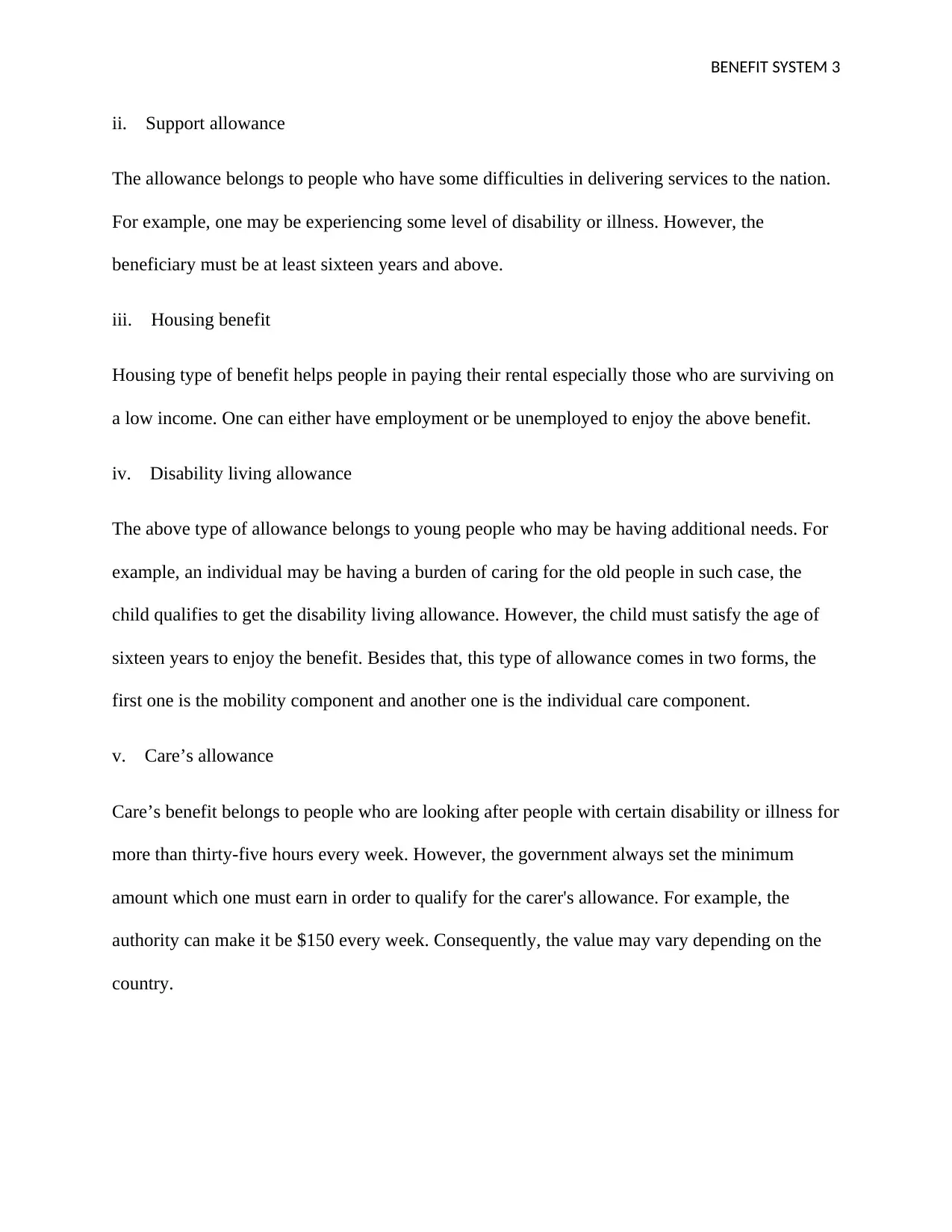
BENEFIT SYSTEM 3
ii. Support allowance
The allowance belongs to people who have some difficulties in delivering services to the nation.
For example, one may be experiencing some level of disability or illness. However, the
beneficiary must be at least sixteen years and above.
iii. Housing benefit
Housing type of benefit helps people in paying their rental especially those who are surviving on
a low income. One can either have employment or be unemployed to enjoy the above benefit.
iv. Disability living allowance
The above type of allowance belongs to young people who may be having additional needs. For
example, an individual may be having a burden of caring for the old people in such case, the
child qualifies to get the disability living allowance. However, the child must satisfy the age of
sixteen years to enjoy the benefit. Besides that, this type of allowance comes in two forms, the
first one is the mobility component and another one is the individual care component.
v. Care’s allowance
Care’s benefit belongs to people who are looking after people with certain disability or illness for
more than thirty-five hours every week. However, the government always set the minimum
amount which one must earn in order to qualify for the carer's allowance. For example, the
authority can make it be $150 every week. Consequently, the value may vary depending on the
country.
ii. Support allowance
The allowance belongs to people who have some difficulties in delivering services to the nation.
For example, one may be experiencing some level of disability or illness. However, the
beneficiary must be at least sixteen years and above.
iii. Housing benefit
Housing type of benefit helps people in paying their rental especially those who are surviving on
a low income. One can either have employment or be unemployed to enjoy the above benefit.
iv. Disability living allowance
The above type of allowance belongs to young people who may be having additional needs. For
example, an individual may be having a burden of caring for the old people in such case, the
child qualifies to get the disability living allowance. However, the child must satisfy the age of
sixteen years to enjoy the benefit. Besides that, this type of allowance comes in two forms, the
first one is the mobility component and another one is the individual care component.
v. Care’s allowance
Care’s benefit belongs to people who are looking after people with certain disability or illness for
more than thirty-five hours every week. However, the government always set the minimum
amount which one must earn in order to qualify for the carer's allowance. For example, the
authority can make it be $150 every week. Consequently, the value may vary depending on the
country.
⊘ This is a preview!⊘
Do you want full access?
Subscribe today to unlock all pages.

Trusted by 1+ million students worldwide
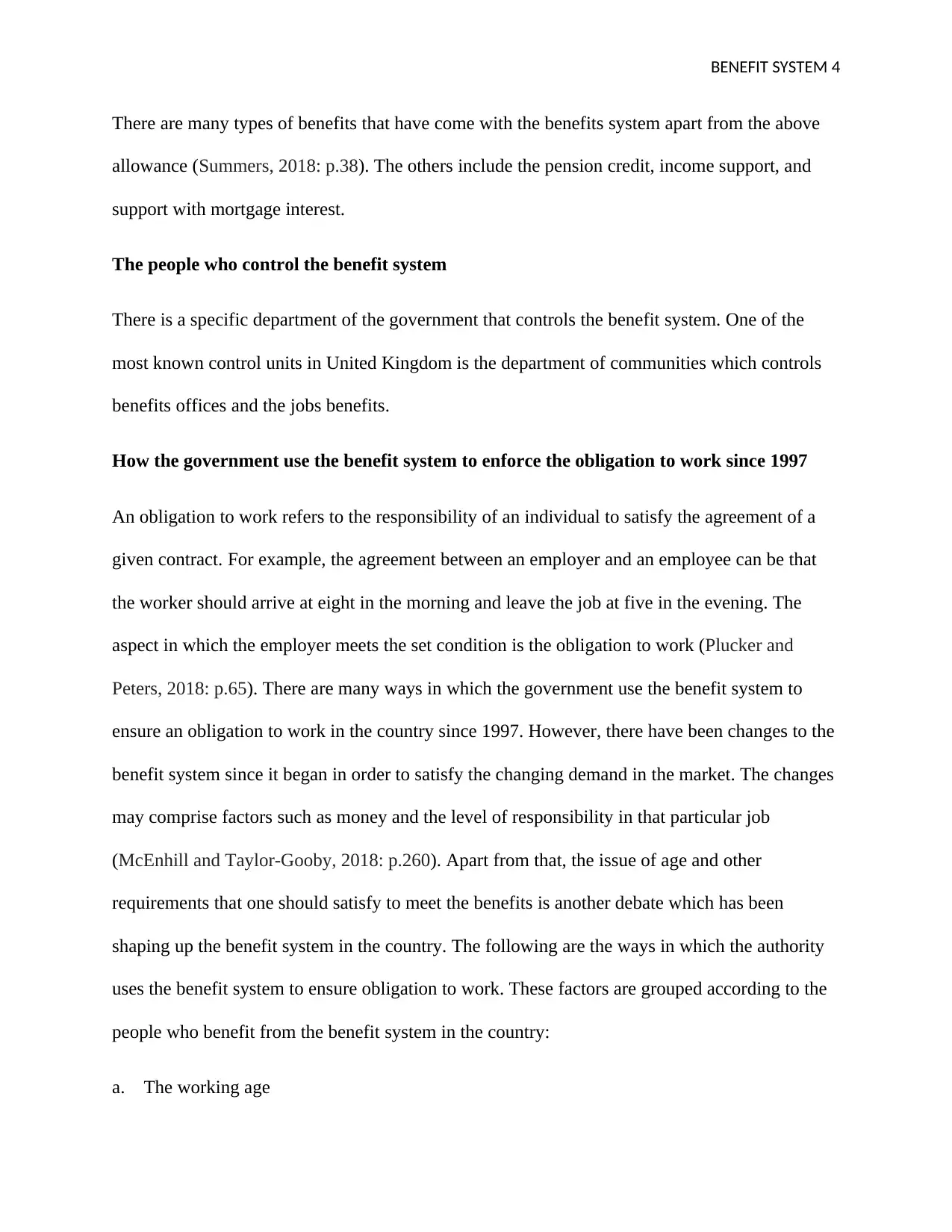
BENEFIT SYSTEM 4
There are many types of benefits that have come with the benefits system apart from the above
allowance (Summers, 2018: p.38). The others include the pension credit, income support, and
support with mortgage interest.
The people who control the benefit system
There is a specific department of the government that controls the benefit system. One of the
most known control units in United Kingdom is the department of communities which controls
benefits offices and the jobs benefits.
How the government use the benefit system to enforce the obligation to work since 1997
An obligation to work refers to the responsibility of an individual to satisfy the agreement of a
given contract. For example, the agreement between an employer and an employee can be that
the worker should arrive at eight in the morning and leave the job at five in the evening. The
aspect in which the employer meets the set condition is the obligation to work (Plucker and
Peters, 2018: p.65). There are many ways in which the government use the benefit system to
ensure an obligation to work in the country since 1997. However, there have been changes to the
benefit system since it began in order to satisfy the changing demand in the market. The changes
may comprise factors such as money and the level of responsibility in that particular job
(McEnhill and Taylor‐Gooby, 2018: p.260). Apart from that, the issue of age and other
requirements that one should satisfy to meet the benefits is another debate which has been
shaping up the benefit system in the country. The following are the ways in which the authority
uses the benefit system to ensure obligation to work. These factors are grouped according to the
people who benefit from the benefit system in the country:
a. The working age
There are many types of benefits that have come with the benefits system apart from the above
allowance (Summers, 2018: p.38). The others include the pension credit, income support, and
support with mortgage interest.
The people who control the benefit system
There is a specific department of the government that controls the benefit system. One of the
most known control units in United Kingdom is the department of communities which controls
benefits offices and the jobs benefits.
How the government use the benefit system to enforce the obligation to work since 1997
An obligation to work refers to the responsibility of an individual to satisfy the agreement of a
given contract. For example, the agreement between an employer and an employee can be that
the worker should arrive at eight in the morning and leave the job at five in the evening. The
aspect in which the employer meets the set condition is the obligation to work (Plucker and
Peters, 2018: p.65). There are many ways in which the government use the benefit system to
ensure an obligation to work in the country since 1997. However, there have been changes to the
benefit system since it began in order to satisfy the changing demand in the market. The changes
may comprise factors such as money and the level of responsibility in that particular job
(McEnhill and Taylor‐Gooby, 2018: p.260). Apart from that, the issue of age and other
requirements that one should satisfy to meet the benefits is another debate which has been
shaping up the benefit system in the country. The following are the ways in which the authority
uses the benefit system to ensure obligation to work. These factors are grouped according to the
people who benefit from the benefit system in the country:
a. The working age
Paraphrase This Document
Need a fresh take? Get an instant paraphrase of this document with our AI Paraphraser
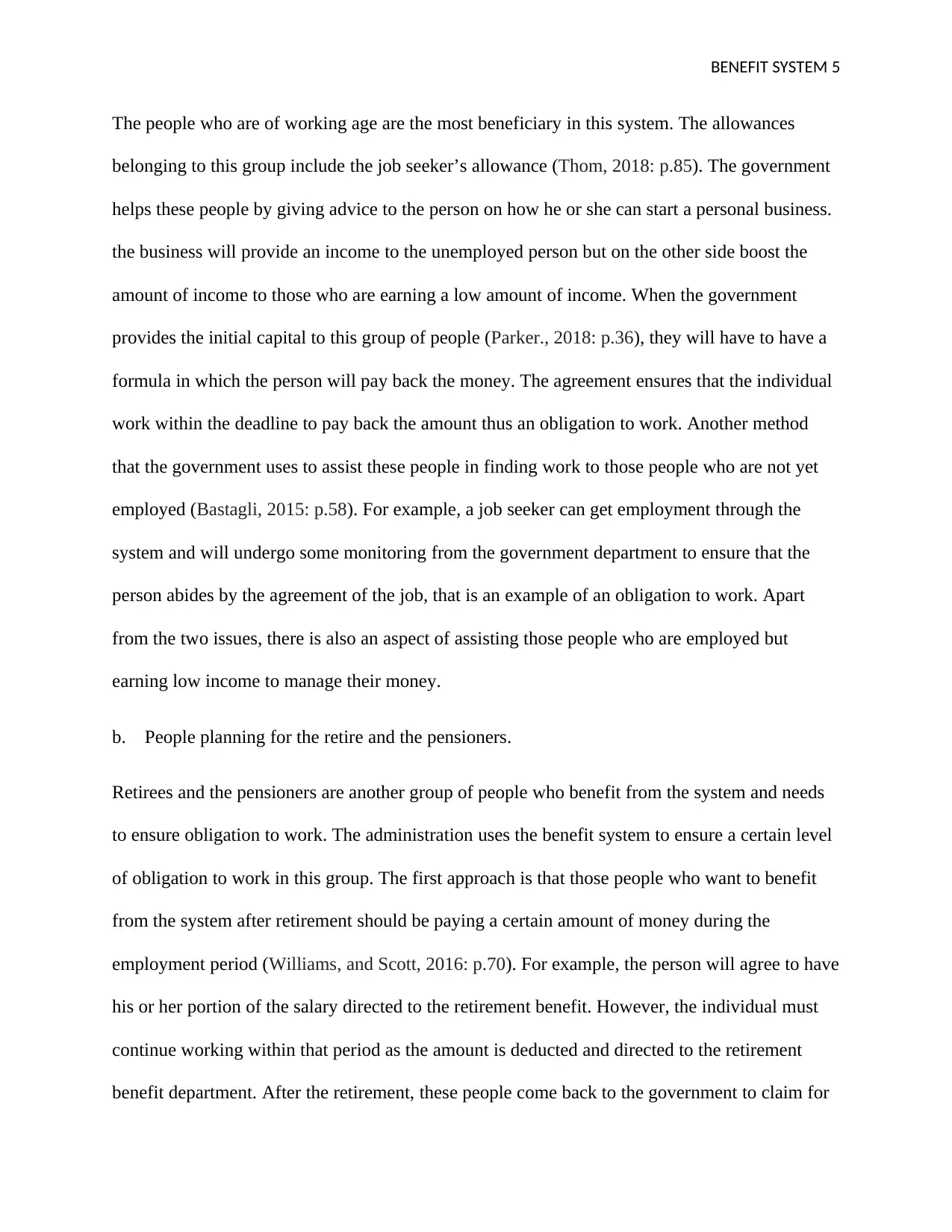
BENEFIT SYSTEM 5
The people who are of working age are the most beneficiary in this system. The allowances
belonging to this group include the job seeker’s allowance (Thom, 2018: p.85). The government
helps these people by giving advice to the person on how he or she can start a personal business.
the business will provide an income to the unemployed person but on the other side boost the
amount of income to those who are earning a low amount of income. When the government
provides the initial capital to this group of people (Parker., 2018: p.36), they will have to have a
formula in which the person will pay back the money. The agreement ensures that the individual
work within the deadline to pay back the amount thus an obligation to work. Another method
that the government uses to assist these people in finding work to those people who are not yet
employed (Bastagli, 2015: p.58). For example, a job seeker can get employment through the
system and will undergo some monitoring from the government department to ensure that the
person abides by the agreement of the job, that is an example of an obligation to work. Apart
from the two issues, there is also an aspect of assisting those people who are employed but
earning low income to manage their money.
b. People planning for the retire and the pensioners.
Retirees and the pensioners are another group of people who benefit from the system and needs
to ensure obligation to work. The administration uses the benefit system to ensure a certain level
of obligation to work in this group. The first approach is that those people who want to benefit
from the system after retirement should be paying a certain amount of money during the
employment period (Williams, and Scott, 2016: p.70). For example, the person will agree to have
his or her portion of the salary directed to the retirement benefit. However, the individual must
continue working within that period as the amount is deducted and directed to the retirement
benefit department. After the retirement, these people come back to the government to claim for
The people who are of working age are the most beneficiary in this system. The allowances
belonging to this group include the job seeker’s allowance (Thom, 2018: p.85). The government
helps these people by giving advice to the person on how he or she can start a personal business.
the business will provide an income to the unemployed person but on the other side boost the
amount of income to those who are earning a low amount of income. When the government
provides the initial capital to this group of people (Parker., 2018: p.36), they will have to have a
formula in which the person will pay back the money. The agreement ensures that the individual
work within the deadline to pay back the amount thus an obligation to work. Another method
that the government uses to assist these people in finding work to those people who are not yet
employed (Bastagli, 2015: p.58). For example, a job seeker can get employment through the
system and will undergo some monitoring from the government department to ensure that the
person abides by the agreement of the job, that is an example of an obligation to work. Apart
from the two issues, there is also an aspect of assisting those people who are employed but
earning low income to manage their money.
b. People planning for the retire and the pensioners.
Retirees and the pensioners are another group of people who benefit from the system and needs
to ensure obligation to work. The administration uses the benefit system to ensure a certain level
of obligation to work in this group. The first approach is that those people who want to benefit
from the system after retirement should be paying a certain amount of money during the
employment period (Williams, and Scott, 2016: p.70). For example, the person will agree to have
his or her portion of the salary directed to the retirement benefit. However, the individual must
continue working within that period as the amount is deducted and directed to the retirement
benefit department. After the retirement, these people come back to the government to claim for
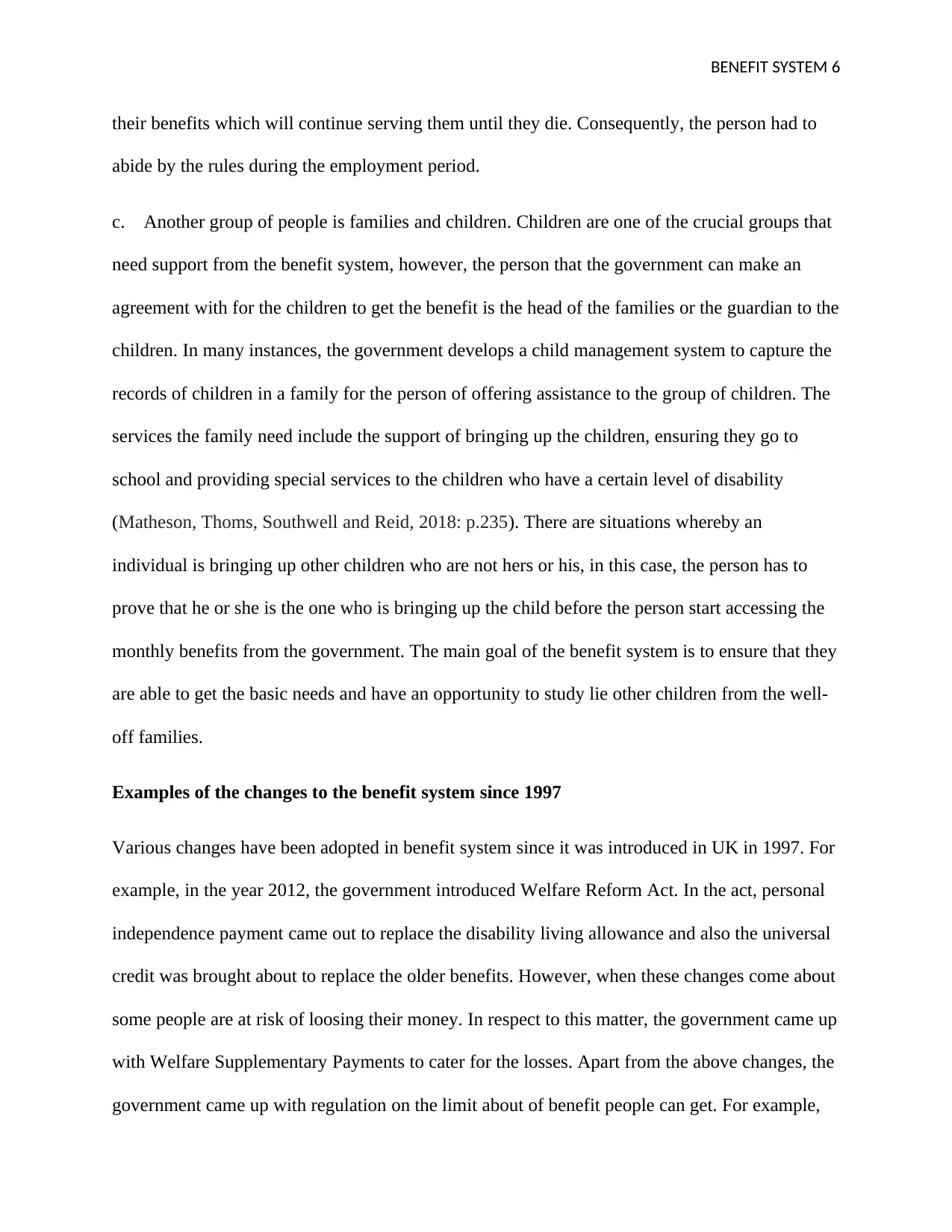
BENEFIT SYSTEM 6
their benefits which will continue serving them until they die. Consequently, the person had to
abide by the rules during the employment period.
c. Another group of people is families and children. Children are one of the crucial groups that
need support from the benefit system, however, the person that the government can make an
agreement with for the children to get the benefit is the head of the families or the guardian to the
children. In many instances, the government develops a child management system to capture the
records of children in a family for the person of offering assistance to the group of children. The
services the family need include the support of bringing up the children, ensuring they go to
school and providing special services to the children who have a certain level of disability
(Matheson, Thoms, Southwell and Reid, 2018: p.235). There are situations whereby an
individual is bringing up other children who are not hers or his, in this case, the person has to
prove that he or she is the one who is bringing up the child before the person start accessing the
monthly benefits from the government. The main goal of the benefit system is to ensure that they
are able to get the basic needs and have an opportunity to study lie other children from the well-
off families.
Examples of the changes to the benefit system since 1997
Various changes have been adopted in benefit system since it was introduced in UK in 1997. For
example, in the year 2012, the government introduced Welfare Reform Act. In the act, personal
independence payment came out to replace the disability living allowance and also the universal
credit was brought about to replace the older benefits. However, when these changes come about
some people are at risk of loosing their money. In respect to this matter, the government came up
with Welfare Supplementary Payments to cater for the losses. Apart from the above changes, the
government came up with regulation on the limit about of benefit people can get. For example,
their benefits which will continue serving them until they die. Consequently, the person had to
abide by the rules during the employment period.
c. Another group of people is families and children. Children are one of the crucial groups that
need support from the benefit system, however, the person that the government can make an
agreement with for the children to get the benefit is the head of the families or the guardian to the
children. In many instances, the government develops a child management system to capture the
records of children in a family for the person of offering assistance to the group of children. The
services the family need include the support of bringing up the children, ensuring they go to
school and providing special services to the children who have a certain level of disability
(Matheson, Thoms, Southwell and Reid, 2018: p.235). There are situations whereby an
individual is bringing up other children who are not hers or his, in this case, the person has to
prove that he or she is the one who is bringing up the child before the person start accessing the
monthly benefits from the government. The main goal of the benefit system is to ensure that they
are able to get the basic needs and have an opportunity to study lie other children from the well-
off families.
Examples of the changes to the benefit system since 1997
Various changes have been adopted in benefit system since it was introduced in UK in 1997. For
example, in the year 2012, the government introduced Welfare Reform Act. In the act, personal
independence payment came out to replace the disability living allowance and also the universal
credit was brought about to replace the older benefits. However, when these changes come about
some people are at risk of loosing their money. In respect to this matter, the government came up
with Welfare Supplementary Payments to cater for the losses. Apart from the above changes, the
government came up with regulation on the limit about of benefit people can get. For example,
⊘ This is a preview!⊘
Do you want full access?
Subscribe today to unlock all pages.

Trusted by 1+ million students worldwide
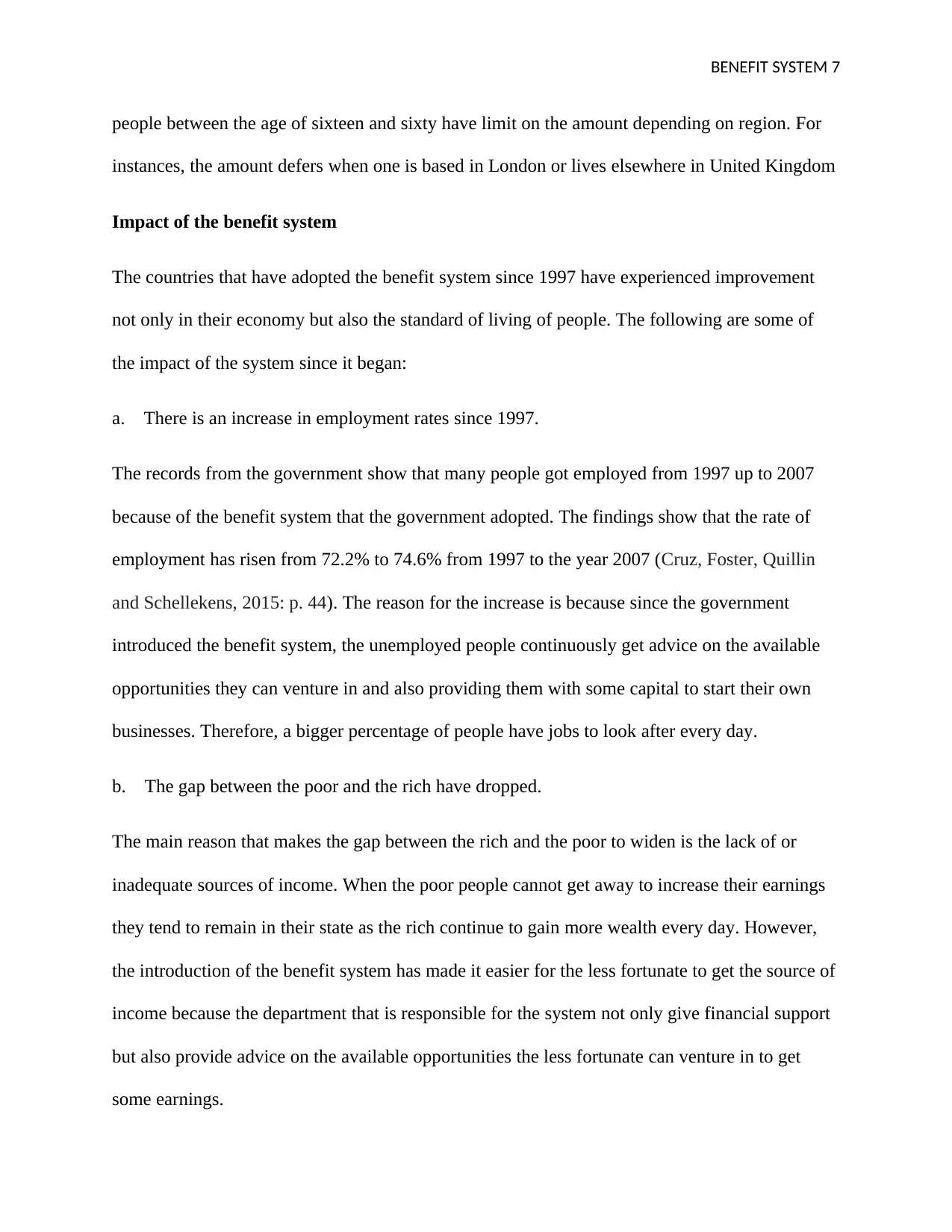
BENEFIT SYSTEM 7
people between the age of sixteen and sixty have limit on the amount depending on region. For
instances, the amount defers when one is based in London or lives elsewhere in United Kingdom
Impact of the benefit system
The countries that have adopted the benefit system since 1997 have experienced improvement
not only in their economy but also the standard of living of people. The following are some of
the impact of the system since it began:
a. There is an increase in employment rates since 1997.
The records from the government show that many people got employed from 1997 up to 2007
because of the benefit system that the government adopted. The findings show that the rate of
employment has risen from 72.2% to 74.6% from 1997 to the year 2007 (Cruz, Foster, Quillin
and Schellekens, 2015: p. 44). The reason for the increase is because since the government
introduced the benefit system, the unemployed people continuously get advice on the available
opportunities they can venture in and also providing them with some capital to start their own
businesses. Therefore, a bigger percentage of people have jobs to look after every day.
b. The gap between the poor and the rich have dropped.
The main reason that makes the gap between the rich and the poor to widen is the lack of or
inadequate sources of income. When the poor people cannot get away to increase their earnings
they tend to remain in their state as the rich continue to gain more wealth every day. However,
the introduction of the benefit system has made it easier for the less fortunate to get the source of
income because the department that is responsible for the system not only give financial support
but also provide advice on the available opportunities the less fortunate can venture in to get
some earnings.
people between the age of sixteen and sixty have limit on the amount depending on region. For
instances, the amount defers when one is based in London or lives elsewhere in United Kingdom
Impact of the benefit system
The countries that have adopted the benefit system since 1997 have experienced improvement
not only in their economy but also the standard of living of people. The following are some of
the impact of the system since it began:
a. There is an increase in employment rates since 1997.
The records from the government show that many people got employed from 1997 up to 2007
because of the benefit system that the government adopted. The findings show that the rate of
employment has risen from 72.2% to 74.6% from 1997 to the year 2007 (Cruz, Foster, Quillin
and Schellekens, 2015: p. 44). The reason for the increase is because since the government
introduced the benefit system, the unemployed people continuously get advice on the available
opportunities they can venture in and also providing them with some capital to start their own
businesses. Therefore, a bigger percentage of people have jobs to look after every day.
b. The gap between the poor and the rich have dropped.
The main reason that makes the gap between the rich and the poor to widen is the lack of or
inadequate sources of income. When the poor people cannot get away to increase their earnings
they tend to remain in their state as the rich continue to gain more wealth every day. However,
the introduction of the benefit system has made it easier for the less fortunate to get the source of
income because the department that is responsible for the system not only give financial support
but also provide advice on the available opportunities the less fortunate can venture in to get
some earnings.
Paraphrase This Document
Need a fresh take? Get an instant paraphrase of this document with our AI Paraphraser
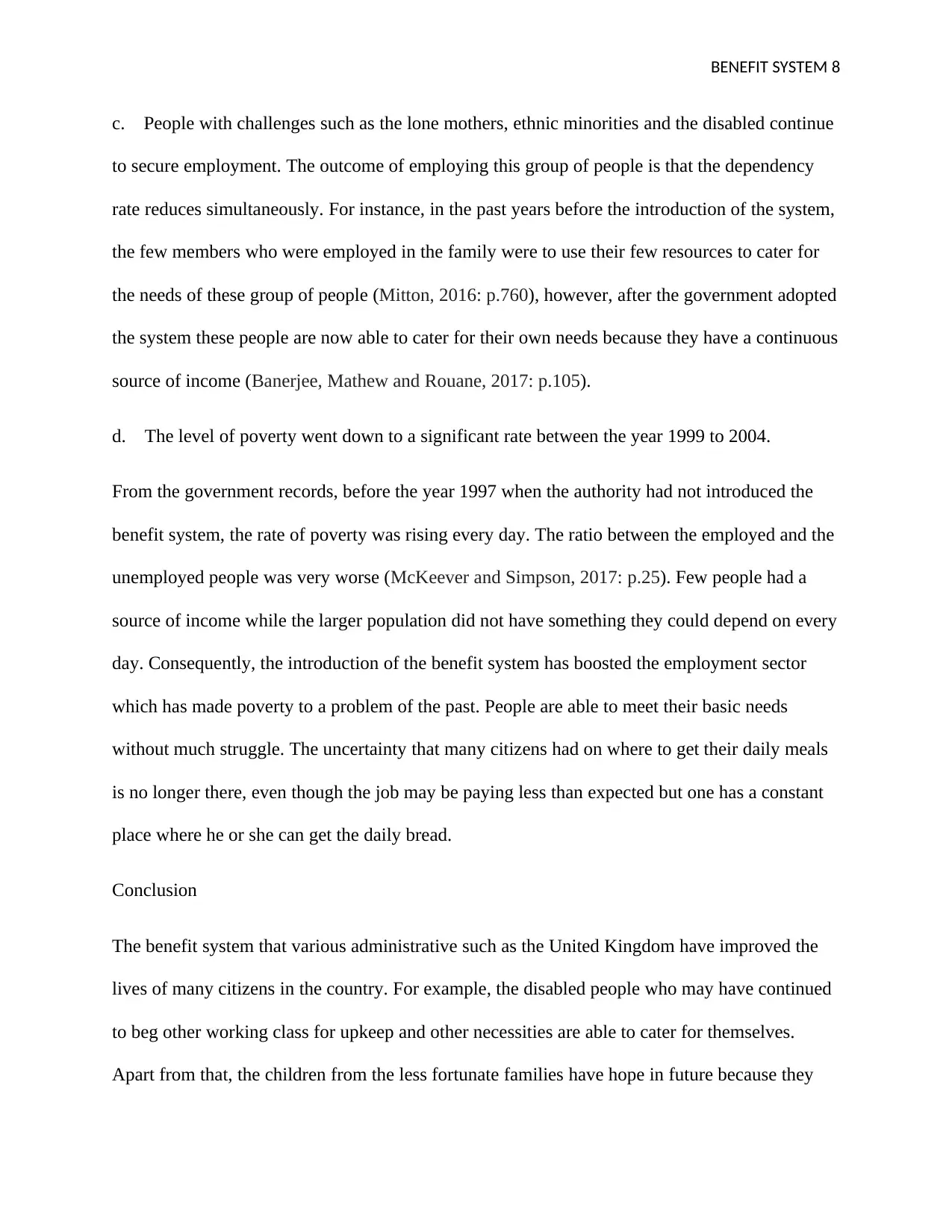
BENEFIT SYSTEM 8
c. People with challenges such as the lone mothers, ethnic minorities and the disabled continue
to secure employment. The outcome of employing this group of people is that the dependency
rate reduces simultaneously. For instance, in the past years before the introduction of the system,
the few members who were employed in the family were to use their few resources to cater for
the needs of these group of people (Mitton, 2016: p.760), however, after the government adopted
the system these people are now able to cater for their own needs because they have a continuous
source of income (Banerjee, Mathew and Rouane, 2017: p.105).
d. The level of poverty went down to a significant rate between the year 1999 to 2004.
From the government records, before the year 1997 when the authority had not introduced the
benefit system, the rate of poverty was rising every day. The ratio between the employed and the
unemployed people was very worse (McKeever and Simpson, 2017: p.25). Few people had a
source of income while the larger population did not have something they could depend on every
day. Consequently, the introduction of the benefit system has boosted the employment sector
which has made poverty to a problem of the past. People are able to meet their basic needs
without much struggle. The uncertainty that many citizens had on where to get their daily meals
is no longer there, even though the job may be paying less than expected but one has a constant
place where he or she can get the daily bread.
Conclusion
The benefit system that various administrative such as the United Kingdom have improved the
lives of many citizens in the country. For example, the disabled people who may have continued
to beg other working class for upkeep and other necessities are able to cater for themselves.
Apart from that, the children from the less fortunate families have hope in future because they
c. People with challenges such as the lone mothers, ethnic minorities and the disabled continue
to secure employment. The outcome of employing this group of people is that the dependency
rate reduces simultaneously. For instance, in the past years before the introduction of the system,
the few members who were employed in the family were to use their few resources to cater for
the needs of these group of people (Mitton, 2016: p.760), however, after the government adopted
the system these people are now able to cater for their own needs because they have a continuous
source of income (Banerjee, Mathew and Rouane, 2017: p.105).
d. The level of poverty went down to a significant rate between the year 1999 to 2004.
From the government records, before the year 1997 when the authority had not introduced the
benefit system, the rate of poverty was rising every day. The ratio between the employed and the
unemployed people was very worse (McKeever and Simpson, 2017: p.25). Few people had a
source of income while the larger population did not have something they could depend on every
day. Consequently, the introduction of the benefit system has boosted the employment sector
which has made poverty to a problem of the past. People are able to meet their basic needs
without much struggle. The uncertainty that many citizens had on where to get their daily meals
is no longer there, even though the job may be paying less than expected but one has a constant
place where he or she can get the daily bread.
Conclusion
The benefit system that various administrative such as the United Kingdom have improved the
lives of many citizens in the country. For example, the disabled people who may have continued
to beg other working class for upkeep and other necessities are able to cater for themselves.
Apart from that, the children from the less fortunate families have hope in future because they
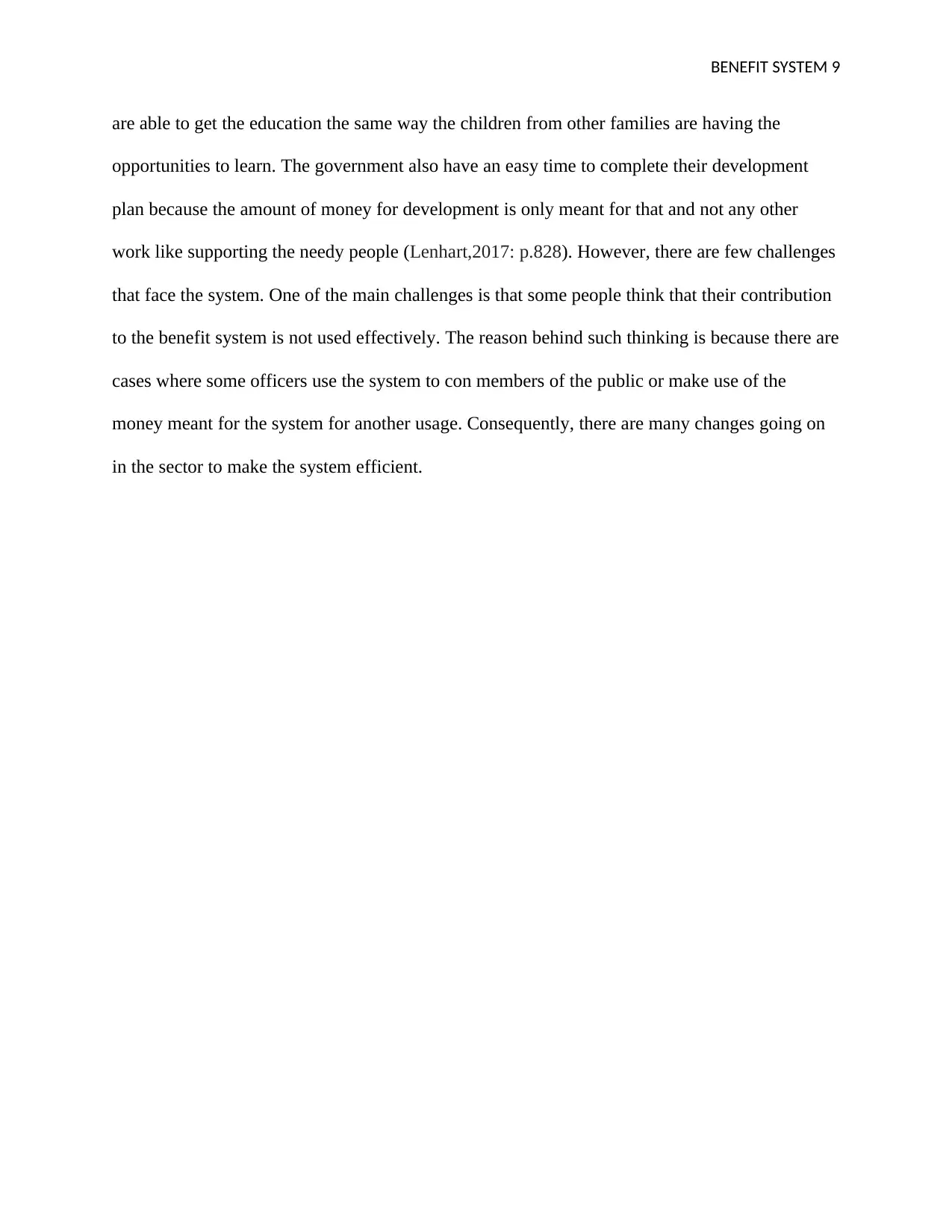
BENEFIT SYSTEM 9
are able to get the education the same way the children from other families are having the
opportunities to learn. The government also have an easy time to complete their development
plan because the amount of money for development is only meant for that and not any other
work like supporting the needy people (Lenhart,2017: p.828). However, there are few challenges
that face the system. One of the main challenges is that some people think that their contribution
to the benefit system is not used effectively. The reason behind such thinking is because there are
cases where some officers use the system to con members of the public or make use of the
money meant for the system for another usage. Consequently, there are many changes going on
in the sector to make the system efficient.
are able to get the education the same way the children from other families are having the
opportunities to learn. The government also have an easy time to complete their development
plan because the amount of money for development is only meant for that and not any other
work like supporting the needy people (Lenhart,2017: p.828). However, there are few challenges
that face the system. One of the main challenges is that some people think that their contribution
to the benefit system is not used effectively. The reason behind such thinking is because there are
cases where some officers use the system to con members of the public or make use of the
money meant for the system for another usage. Consequently, there are many changes going on
in the sector to make the system efficient.
⊘ This is a preview!⊘
Do you want full access?
Subscribe today to unlock all pages.

Trusted by 1+ million students worldwide
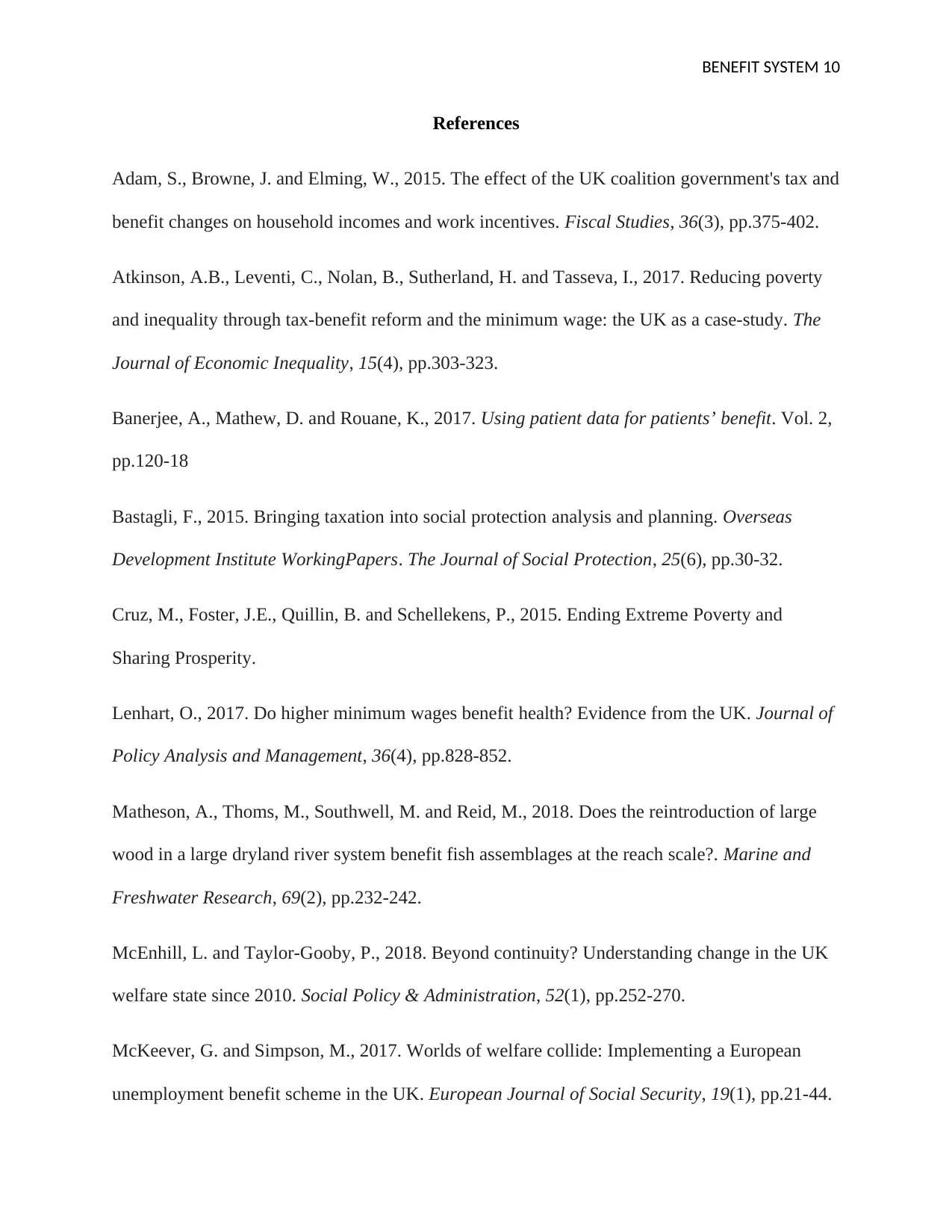
BENEFIT SYSTEM 10
References
Adam, S., Browne, J. and Elming, W., 2015. The effect of the UK coalition government's tax and
benefit changes on household incomes and work incentives. Fiscal Studies, 36(3), pp.375-402.
Atkinson, A.B., Leventi, C., Nolan, B., Sutherland, H. and Tasseva, I., 2017. Reducing poverty
and inequality through tax-benefit reform and the minimum wage: the UK as a case-study. The
Journal of Economic Inequality, 15(4), pp.303-323.
Banerjee, A., Mathew, D. and Rouane, K., 2017. Using patient data for patients’ benefit. Vol. 2,
pp.120-18
Bastagli, F., 2015. Bringing taxation into social protection analysis and planning. Overseas
Development Institute WorkingPapers. The Journal of Social Protection, 25(6), pp.30-32.
Cruz, M., Foster, J.E., Quillin, B. and Schellekens, P., 2015. Ending Extreme Poverty and
Sharing Prosperity.
Lenhart, O., 2017. Do higher minimum wages benefit health? Evidence from the UK. Journal of
Policy Analysis and Management, 36(4), pp.828-852.
Matheson, A., Thoms, M., Southwell, M. and Reid, M., 2018. Does the reintroduction of large
wood in a large dryland river system benefit fish assemblages at the reach scale?. Marine and
Freshwater Research, 69(2), pp.232-242.
McEnhill, L. and Taylor‐Gooby, P., 2018. Beyond continuity? Understanding change in the UK
welfare state since 2010. Social Policy & Administration, 52(1), pp.252-270.
McKeever, G. and Simpson, M., 2017. Worlds of welfare collide: Implementing a European
unemployment benefit scheme in the UK. European Journal of Social Security, 19(1), pp.21-44.
References
Adam, S., Browne, J. and Elming, W., 2015. The effect of the UK coalition government's tax and
benefit changes on household incomes and work incentives. Fiscal Studies, 36(3), pp.375-402.
Atkinson, A.B., Leventi, C., Nolan, B., Sutherland, H. and Tasseva, I., 2017. Reducing poverty
and inequality through tax-benefit reform and the minimum wage: the UK as a case-study. The
Journal of Economic Inequality, 15(4), pp.303-323.
Banerjee, A., Mathew, D. and Rouane, K., 2017. Using patient data for patients’ benefit. Vol. 2,
pp.120-18
Bastagli, F., 2015. Bringing taxation into social protection analysis and planning. Overseas
Development Institute WorkingPapers. The Journal of Social Protection, 25(6), pp.30-32.
Cruz, M., Foster, J.E., Quillin, B. and Schellekens, P., 2015. Ending Extreme Poverty and
Sharing Prosperity.
Lenhart, O., 2017. Do higher minimum wages benefit health? Evidence from the UK. Journal of
Policy Analysis and Management, 36(4), pp.828-852.
Matheson, A., Thoms, M., Southwell, M. and Reid, M., 2018. Does the reintroduction of large
wood in a large dryland river system benefit fish assemblages at the reach scale?. Marine and
Freshwater Research, 69(2), pp.232-242.
McEnhill, L. and Taylor‐Gooby, P., 2018. Beyond continuity? Understanding change in the UK
welfare state since 2010. Social Policy & Administration, 52(1), pp.252-270.
McKeever, G. and Simpson, M., 2017. Worlds of welfare collide: Implementing a European
unemployment benefit scheme in the UK. European Journal of Social Security, 19(1), pp.21-44.
Paraphrase This Document
Need a fresh take? Get an instant paraphrase of this document with our AI Paraphraser
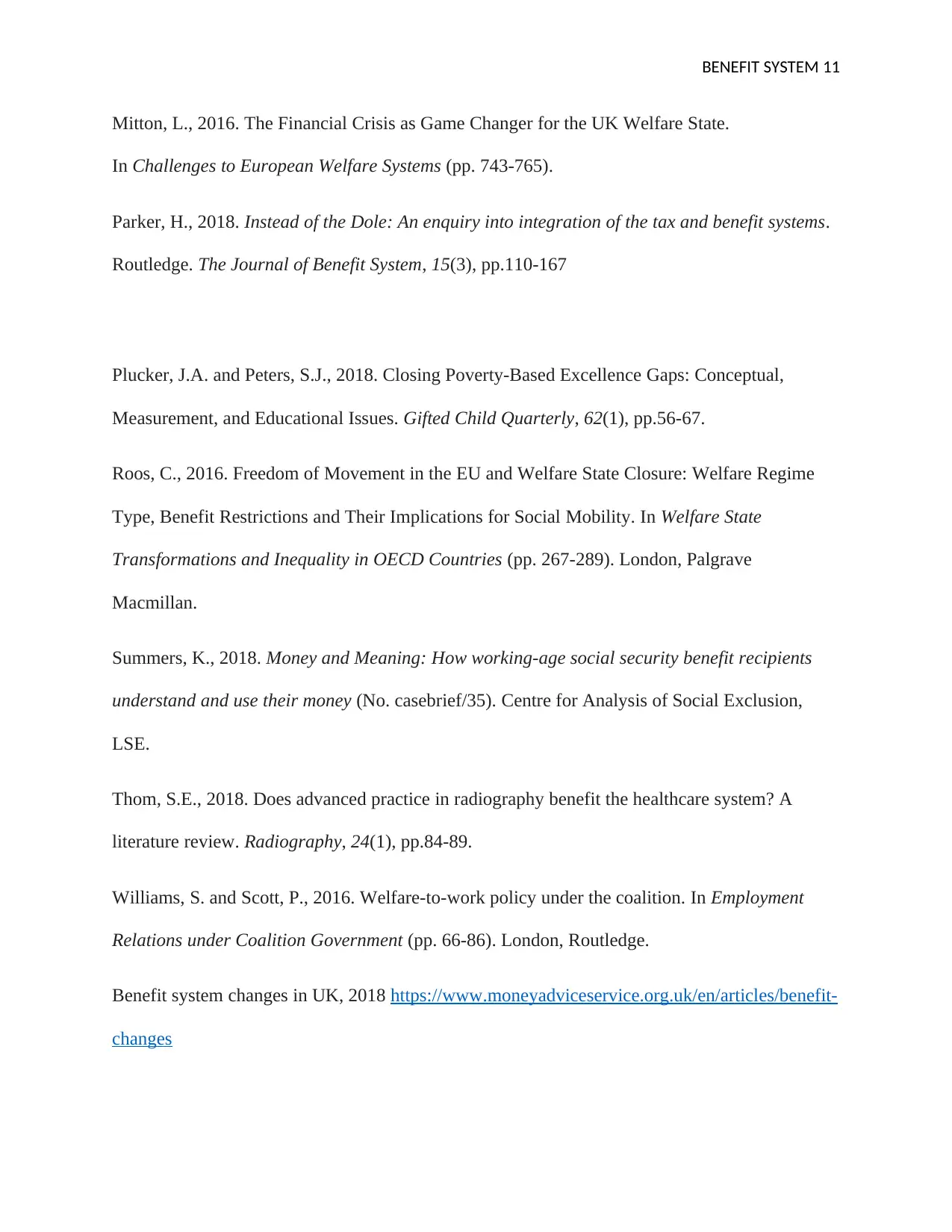
BENEFIT SYSTEM 11
Mitton, L., 2016. The Financial Crisis as Game Changer for the UK Welfare State.
In Challenges to European Welfare Systems (pp. 743-765).
Parker, H., 2018. Instead of the Dole: An enquiry into integration of the tax and benefit systems.
Routledge. The Journal of Benefit System, 15(3), pp.110-167
Plucker, J.A. and Peters, S.J., 2018. Closing Poverty-Based Excellence Gaps: Conceptual,
Measurement, and Educational Issues. Gifted Child Quarterly, 62(1), pp.56-67.
Roos, C., 2016. Freedom of Movement in the EU and Welfare State Closure: Welfare Regime
Type, Benefit Restrictions and Their Implications for Social Mobility. In Welfare State
Transformations and Inequality in OECD Countries (pp. 267-289). London, Palgrave
Macmillan.
Summers, K., 2018. Money and Meaning: How working-age social security benefit recipients
understand and use their money (No. casebrief/35). Centre for Analysis of Social Exclusion,
LSE.
Thom, S.E., 2018. Does advanced practice in radiography benefit the healthcare system? A
literature review. Radiography, 24(1), pp.84-89.
Williams, S. and Scott, P., 2016. Welfare-to-work policy under the coalition. In Employment
Relations under Coalition Government (pp. 66-86). London, Routledge.
Benefit system changes in UK, 2018 https://www.moneyadviceservice.org.uk/en/articles/benefit-
changes
Mitton, L., 2016. The Financial Crisis as Game Changer for the UK Welfare State.
In Challenges to European Welfare Systems (pp. 743-765).
Parker, H., 2018. Instead of the Dole: An enquiry into integration of the tax and benefit systems.
Routledge. The Journal of Benefit System, 15(3), pp.110-167
Plucker, J.A. and Peters, S.J., 2018. Closing Poverty-Based Excellence Gaps: Conceptual,
Measurement, and Educational Issues. Gifted Child Quarterly, 62(1), pp.56-67.
Roos, C., 2016. Freedom of Movement in the EU and Welfare State Closure: Welfare Regime
Type, Benefit Restrictions and Their Implications for Social Mobility. In Welfare State
Transformations and Inequality in OECD Countries (pp. 267-289). London, Palgrave
Macmillan.
Summers, K., 2018. Money and Meaning: How working-age social security benefit recipients
understand and use their money (No. casebrief/35). Centre for Analysis of Social Exclusion,
LSE.
Thom, S.E., 2018. Does advanced practice in radiography benefit the healthcare system? A
literature review. Radiography, 24(1), pp.84-89.
Williams, S. and Scott, P., 2016. Welfare-to-work policy under the coalition. In Employment
Relations under Coalition Government (pp. 66-86). London, Routledge.
Benefit system changes in UK, 2018 https://www.moneyadviceservice.org.uk/en/articles/benefit-
changes
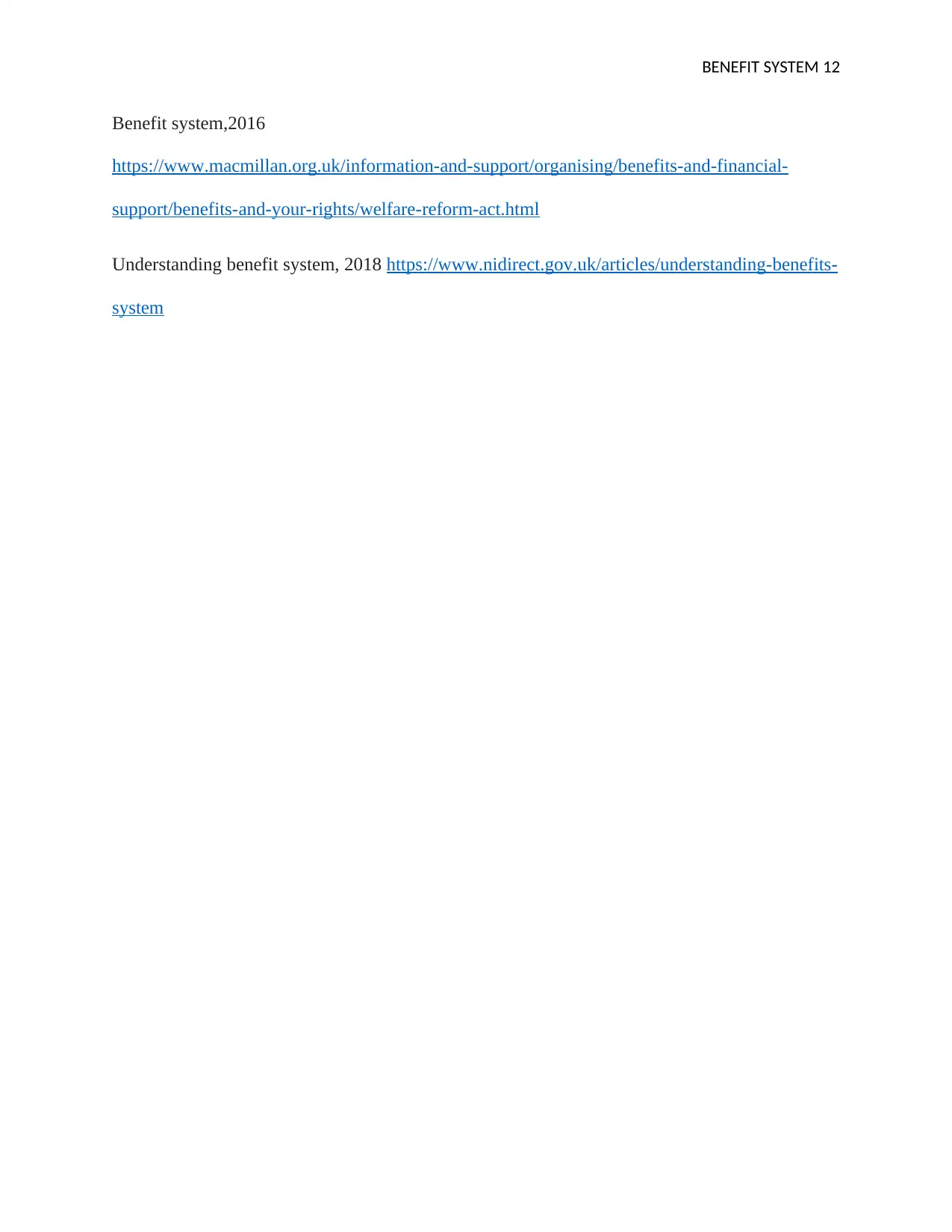
BENEFIT SYSTEM 12
Benefit system,2016
https://www.macmillan.org.uk/information-and-support/organising/benefits-and-financial-
support/benefits-and-your-rights/welfare-reform-act.html
Understanding benefit system, 2018 https://www.nidirect.gov.uk/articles/understanding-benefits-
system
Benefit system,2016
https://www.macmillan.org.uk/information-and-support/organising/benefits-and-financial-
support/benefits-and-your-rights/welfare-reform-act.html
Understanding benefit system, 2018 https://www.nidirect.gov.uk/articles/understanding-benefits-
system
⊘ This is a preview!⊘
Do you want full access?
Subscribe today to unlock all pages.

Trusted by 1+ million students worldwide
1 out of 12
Related Documents
Your All-in-One AI-Powered Toolkit for Academic Success.
+13062052269
info@desklib.com
Available 24*7 on WhatsApp / Email
![[object Object]](/_next/static/media/star-bottom.7253800d.svg)
Unlock your academic potential
Copyright © 2020–2025 A2Z Services. All Rights Reserved. Developed and managed by ZUCOL.





